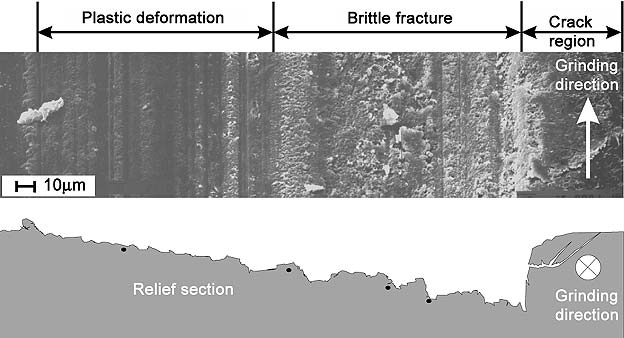4.2.2.1 Ground
Surfaces
The characteristic of grinding is the overlapping
of a large number of scraping movements on fixed paths taken
by grinding grains in one particular direction parallel to
the surface of the workpiece. The scraping movement of the
cutting grains directly induces micro-cracks, brittle breakage
and/or plastic flow, and hence the ductile separation of ceramic
particles.
Figure 67 shows machining tracks which illustrate
the mechanisms by which material becomes separated, with areas
of primarily plastic deformation, of primarily brittle fracture
and of a crack may clearly be distinguished. The crack area
is characterised by microscopic axial, radial and lateral
cracks.
Surfaces whose creation has primarily been
influenced by plastic deformation procedures typically display
scoring, rounding, stratification, flaking and a relatively
small number of break-outs. The process is called "ductile
cutting".
In contrast to this, break-outs, pile-ups, facetting and spalling
are typical of "brittle cutting".
Grinding a surface usually results both in ductile and in
brittle cutting. The dominant mechanism of material separation
depends on the local stress conditions on the individual grains
of the ceramic microstructure during the scraping process.
The changeover from brittle to ductile cutting depends in
particular on exceeding a critical cutting thickness at the
individual grain, but also on the micro-geometries of the
cutting grains.

Bild 67: Unterschiedliche Werkstofftrennmechanismen
bei geschliffenem Siliciumnitrid

Figure 68: Ceramic surfaces subjected to
brittle, mixed and ductile grinding
|

